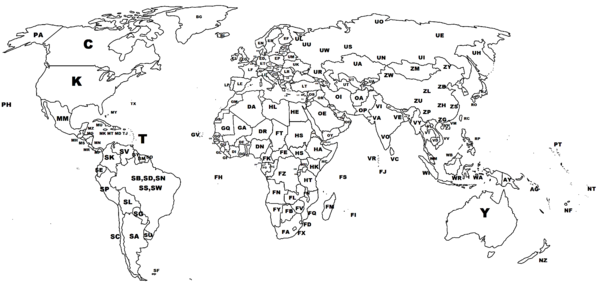International Civil Aviation Organization airport code
ICAO codes are used by air traffic control and airline operations such as flight planning. They differ from IATA codes, which are generally used for airline timetables, reservations, and baggage tags. For example, the IATA code for London's Heathrow Airport is LHR and its ICAO code is EGLL. Most travelers usually see the IATA code on baggage tags and tickets and the ICAO code is used among other things by pilots, air traffic control and flight-tracking services such as FlightAware. In general IATA codes are usually derived from the name of the airport or the city it serves, while ICAO codes are distributed by region and country.
ICAO codes are also used to identify other aviation facilities such as weather stations, International Flight Service Stations or Area Control Centers, whether or not they are located at airports.
The International Civil Aviation Organization was formed in 1947 under the auspices of the United Nations, and it established Flight Information Regions for controlling air traffic and making airport identification simple and clear.
 Code selections in North America were based on existing radio station identifiers. For example, radio stations in Canada were already starting with "C", so it seemed logical to begin Canadian airport identifiers with Cxxx. The United States had many pre-existing airports with established mnemonic codes. Their ICAO codes were formed simply by prepending a K to the existing codes, as half the radio station identifiers in the US began with K. Most ICAO codes outside the US and Canada have a stronger geographical structure.
Code selections in North America were based on existing radio station identifiers. For example, radio stations in Canada were already starting with "C", so it seemed logical to begin Canadian airport identifiers with Cxxx. The United States had many pre-existing airports with established mnemonic codes. Their ICAO codes were formed simply by prepending a K to the existing codes, as half the radio station identifiers in the US began with K. Most ICAO codes outside the US and Canada have a stronger geographical structure.Unlike the IATA codes, the ICAO codes generally have a regional structure, aren't duplicated, and are comprehensive. In general, the 1st letter is allocated by continent and represents a country or group of countries within that continent. The 2nd letter generally represents a country within that region, and the remaining two are used to identify each airport. The exception to this rule is larger countries that have single-letter country codes, where the remaining three letters identify the airport. In either case, ICAO codes generally provide geographical context unlike IATA codes. For example, if one knows that the ICAO code for Heathrow is EGLL, then one can deduce that the airport EGNH is somewhere in the UK. On the other hand, knowing that the IATA code for Heathrow is LHR does not enable one to deduce the location of the airport LHV with any greater certainty (it is William T. Piper Memorial Airport in Lock Haven, Pennsylvania in the United States).
There are a few exceptions to the regional structure of the ICAO code made for political or administrative reasons. For example, the RAF Mount Pleasant air base in the Falkland Islands is assigned the ICAO code EGYP as though it were in the United Kingdom, but a nearby civilian airport such as Port Stanley Airport is assigned SFAL, consistent with South America. Similarly Saint Pierre and Miquelon is controlled by France, and airports there are assigned LFxx as though they were in Europe. Further, in region L, all available 2-letter prefixes have been exhausted and thus no additional countries can be added. Thus when Kosovo declared independence, there was no space in the Lxxx codes to accommodate it, so airports in Kosovo were assigned BKxx, grouping Kosovo with Greenland and Iceland.
The letters I, J and X aren't currently used as the 1st letter of any ICAO identifier. In Russia and CIS, Latin letter X is used to designate government, military and experimental aviation airfields in internal airfield codes similar in structure and purpose to ICAO codes but not used internationally. Q is reserved for international radiocommunications and other non-geographical special uses (see Q code).
In the contiguous United States, Canada and some airports in Mexico, most, but not all, airports have been assigned three-letter IATA codes. These are the same as their ICAO code, but without the leading K, W, or C.; e.g., YYC and CYYC, IAD and KIAD (Washington Dulles International Airport, Chantilly, Virginia). These codes aren't to be confused with radio or television call signs, even though both countries use four-letter call signs starting with those letters. However, because Alaska, Hawaii and United States territories have their own 2-letter ICAO prefix, the situation there is similar to other smaller countries and the ICAO code of their airports is typically different from its corresponding 3-letter FAA/IATA identifier. For example, Hilo International Airport (PHTO vs ITO) and Juneau International Airport (PAJN vs JNU).
ZZZZ is a special code which is used when no ICAO code exists for the airport and is normally used in flight plans.
| A list of airports, available below. | sorted by ICAO code, is - |
Related Sites for International Civil Aviation Organization airport code
- International Civil Aviation Organization read International Civil Aviation Organization airport code
- SKYbrary - International Civil Aviation Organisation (ICAO) read International Civil Aviation Organization airport code
- The International Civil Aviation Organization (ICAO) Overview ... read International Civil Aviation Organization airport code
- ICAO Annex 17: Security : Safeguarding International Civil ... read International Civil Aviation Organization airport code
